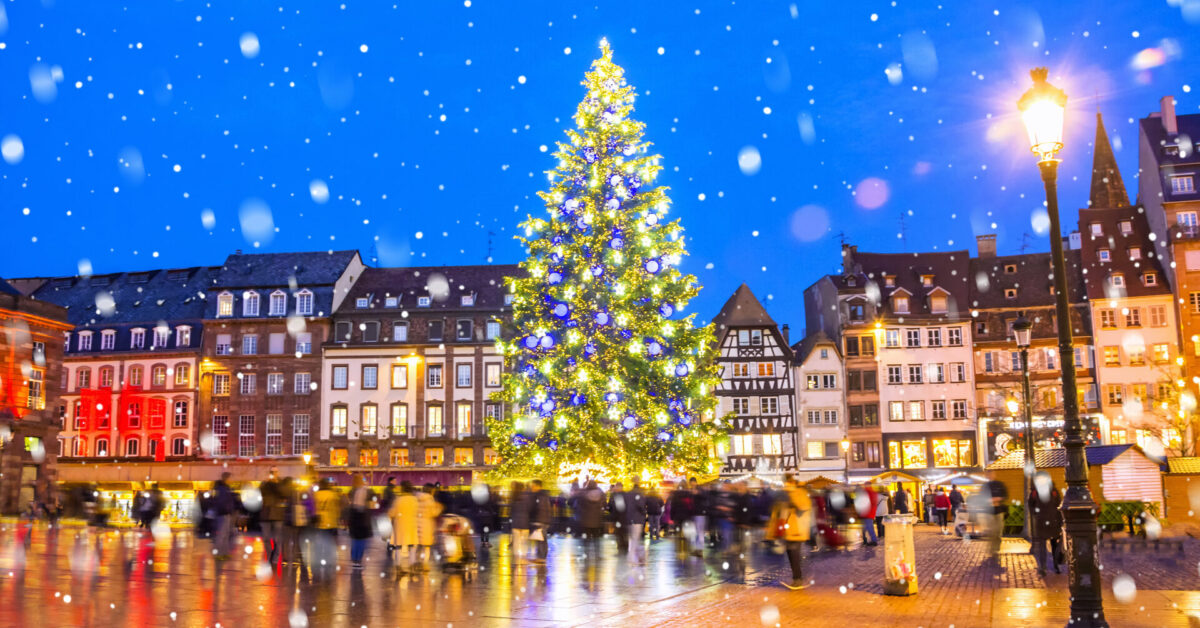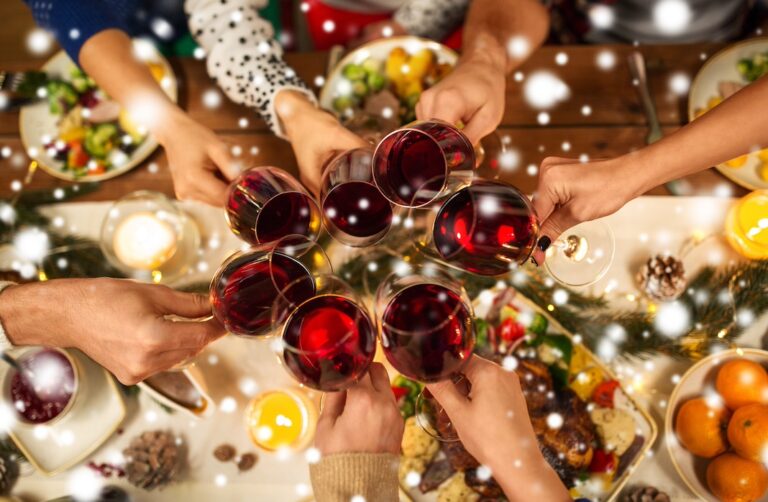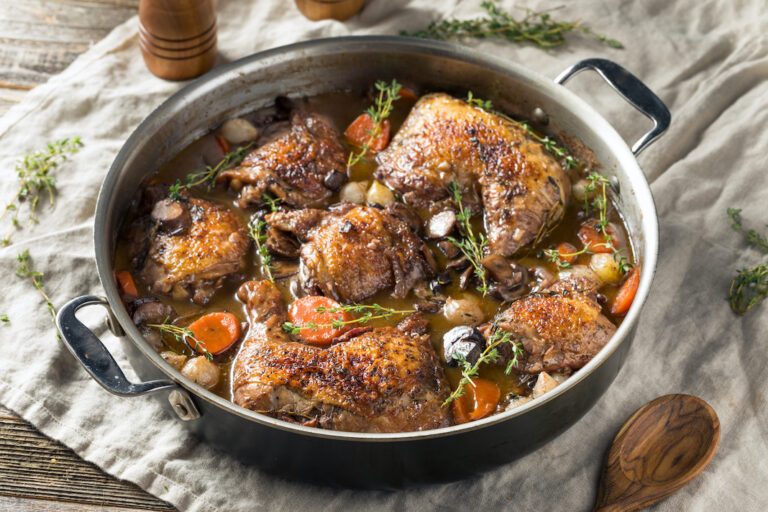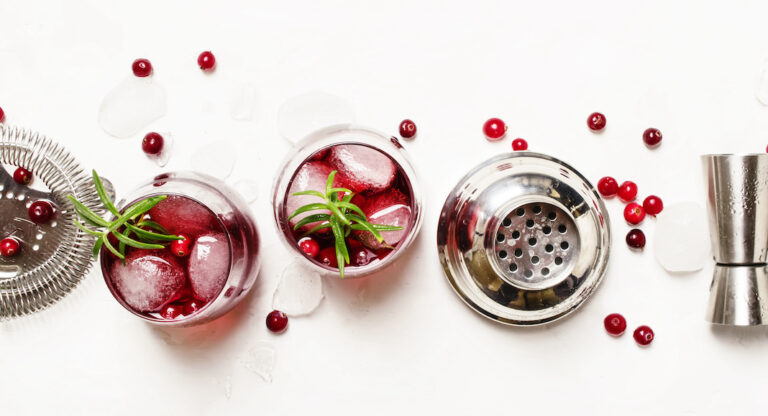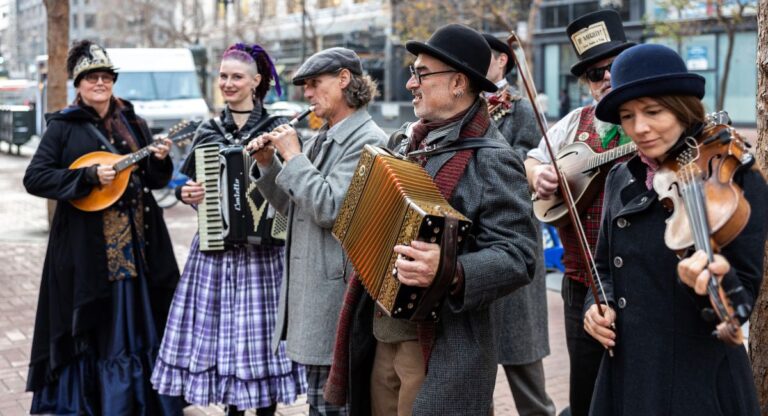Jetting off to France for the holidays or just hoping to add a touch of French flair to your celebrations stateside? We’ve got you covered with a list of eleven French Christmas traditions, from elaborate, multi-course Christmas Eve meals to festive markets complete with mulled wine and roasted chestnuts.
Grab a chocolat chaud and get cozy! The most wonderful time of the year à la française awaits…
10 French Christmas Traditions
1. Starting on December 1, The French Whip Out Their Advent Calendars

Counting down to Christmas with a calendrier de l’Avent is a popular French Christmas tradition for children — even those whose families don’t celebrate the religious holiday. Each day, a “window” on the calendar is opened to reveal a chocolate or small toy. There are even Advent calendars for adults, and it’s become increasingly common for French brands like Diptyque, Dior, Sisley, Guerlain, Angelina, and Palais des Thés to create prized limited editions around Christmas time every year.
2. Nativity Scenes Are Set Up in Town Squares, Churches, and Homes
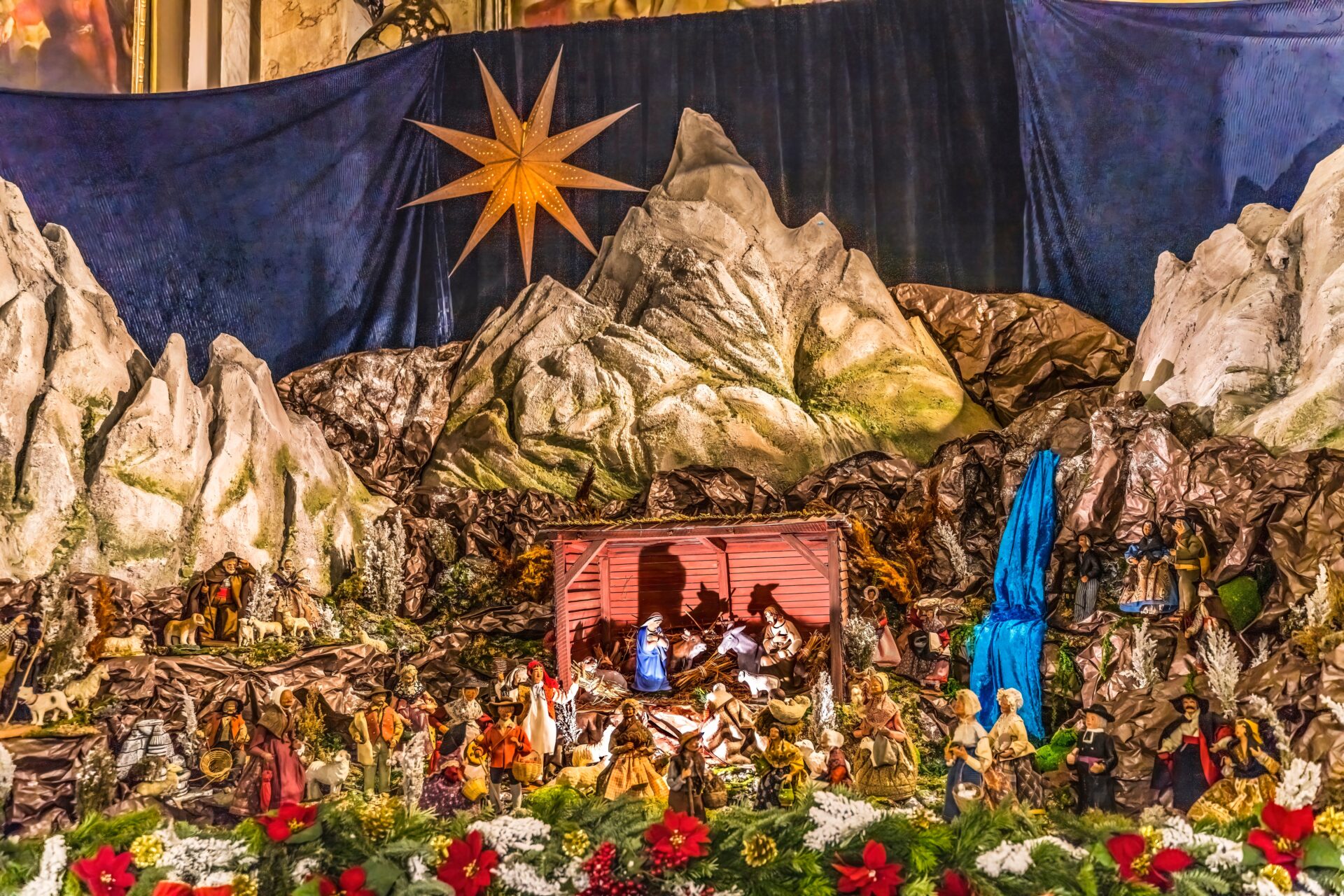
Representing the birth of Jesus in the manger, nativity scenes — or crèches — are one of the most common French Christmas traditions, especially in Provence. The earliest crèches date back to the late sixteenth century, during which time they were mostly found in churches and other public spaces. Facing persecution on the heels of the French Revolution, Christian families began displaying them privately in their own homes, passing down the often elaborate set-ups from generation to generation.
Today, you’ll find them alongside other Christmas decorations such as plastic Santas, mistletoe, and Advent wreaths. In addition to the typical figurines (baby Jesus, Mary, Joseph, three wise men), there are also santons de Noël, or ordinary townspeople gathered around the stable.
3. Festive Christmas Markets Pop Up Throughout France
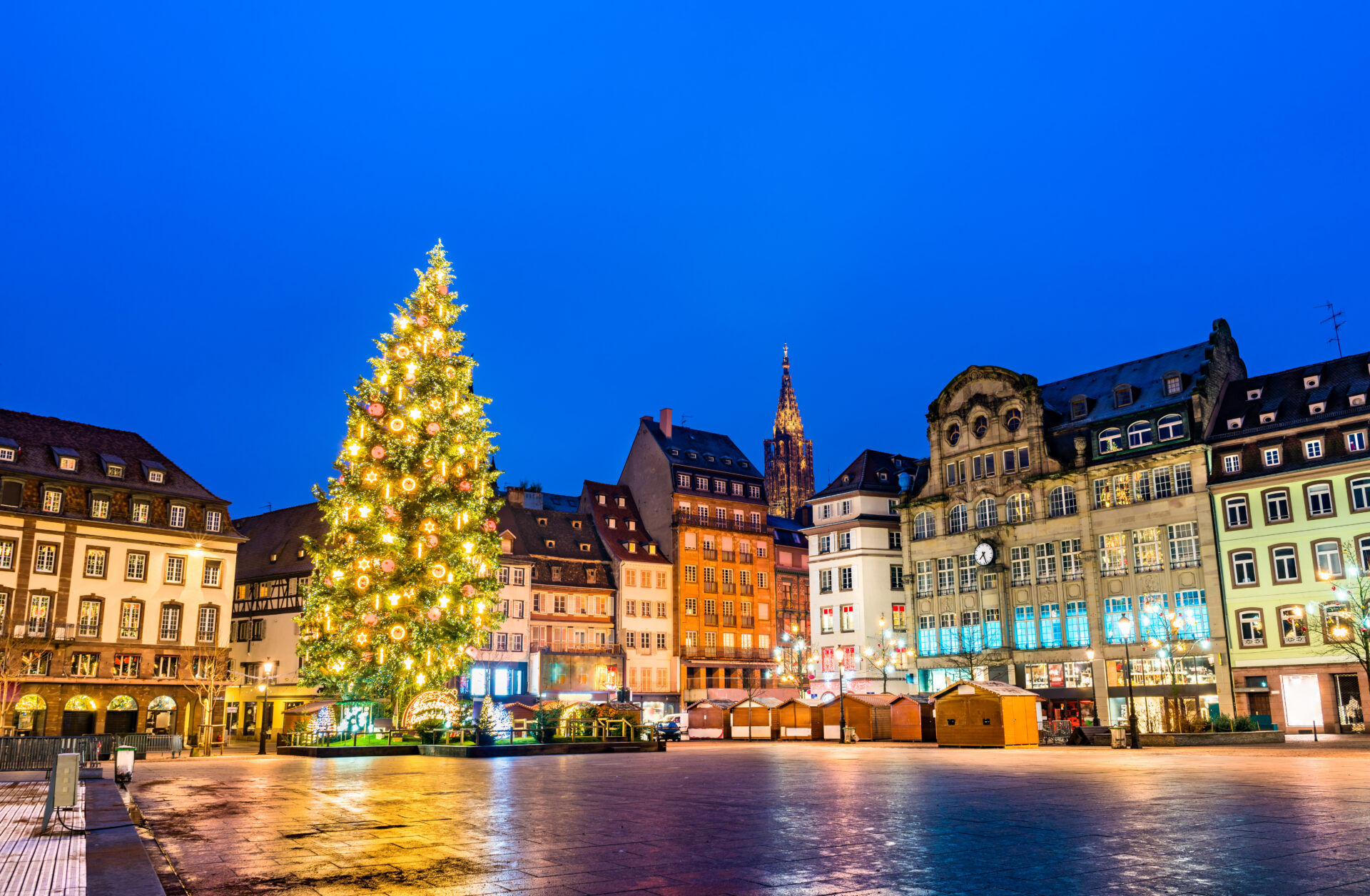
There’s no better way to get in the holiday spirit than to visit a marché de Noël. These enchanting street markets glimmer under Christmas lights, with the comforting aroma of mulled wine and roasted chestnuts filling the air. While there are no bad Christmas markets per se, some are undeniably superior.
Take Strasbourg, for example. The oldest Christmas market in France, the Christkindelsmärik, dates back to 1570 and is one of the most iconic French Christmas traditions in this Alsatian city. Today, the market features upwards of 300 chalets that spill out across the entire city, making it feel like a real-life winter wonderland. It also helps that there’s a soaring, almost 100-foot Christmas tree in the central square.
Other cities with top-notch French Christmas markets? Colmar, Lille, Montbéliard, Metz, Amiens, and Reims. If you’re in Paris, make a beeline for Place Saint-Germain-des-Prés, Place de la Nation, or Place du Trocadéro. You’ll also find a market at the Jardin des Tuileries, but that tends to be a more touristy one.
While you can certainly make progress on your Christmas shopping list, the real attraction — whether you’re at a large or small Christmas market — is the food. Here’s what to keep an eye out for:
- Vin Chaud (Mulled Wine)
With warming spices like cinnamon and cloves. - Roasted Chestnuts
They come in paper cones known as sachets — you can get a small or a large. - Crêpes and Gaufres
Classic French crêpes and delicious Belgian waffles. - Bredele
These traditional Alsatian cookies are flavored with orange and cinnamon. - Pain d’épice
Traditional French gingerbread made with honey, rye flour, and — as the name suggests — no shortage of spices (think ginger, cinnamon, nutmeg, cloves, and anise seeds).
4. Children (and Adults!) Sing French Christmas Songs

While there aren’t nearly as many Christmas songs that originated in France (most are from England or Germany), that doesn’t mean the French are sans festive tunes. Our favorites? Dalida’s 1960 rendition of “Jingle Bells,” called “Vive le Vent;” Tino Rossi’s “Petit Papa Noël” (or Josh Groban’s, if you’re in the mood for something more recent), and “Mon Plus Beau Noël” by Johnny Hallyday. Check out our full guide to French Christmas songs here.
5. French Children Leave Shoes or Socks In Front of The Fireplace
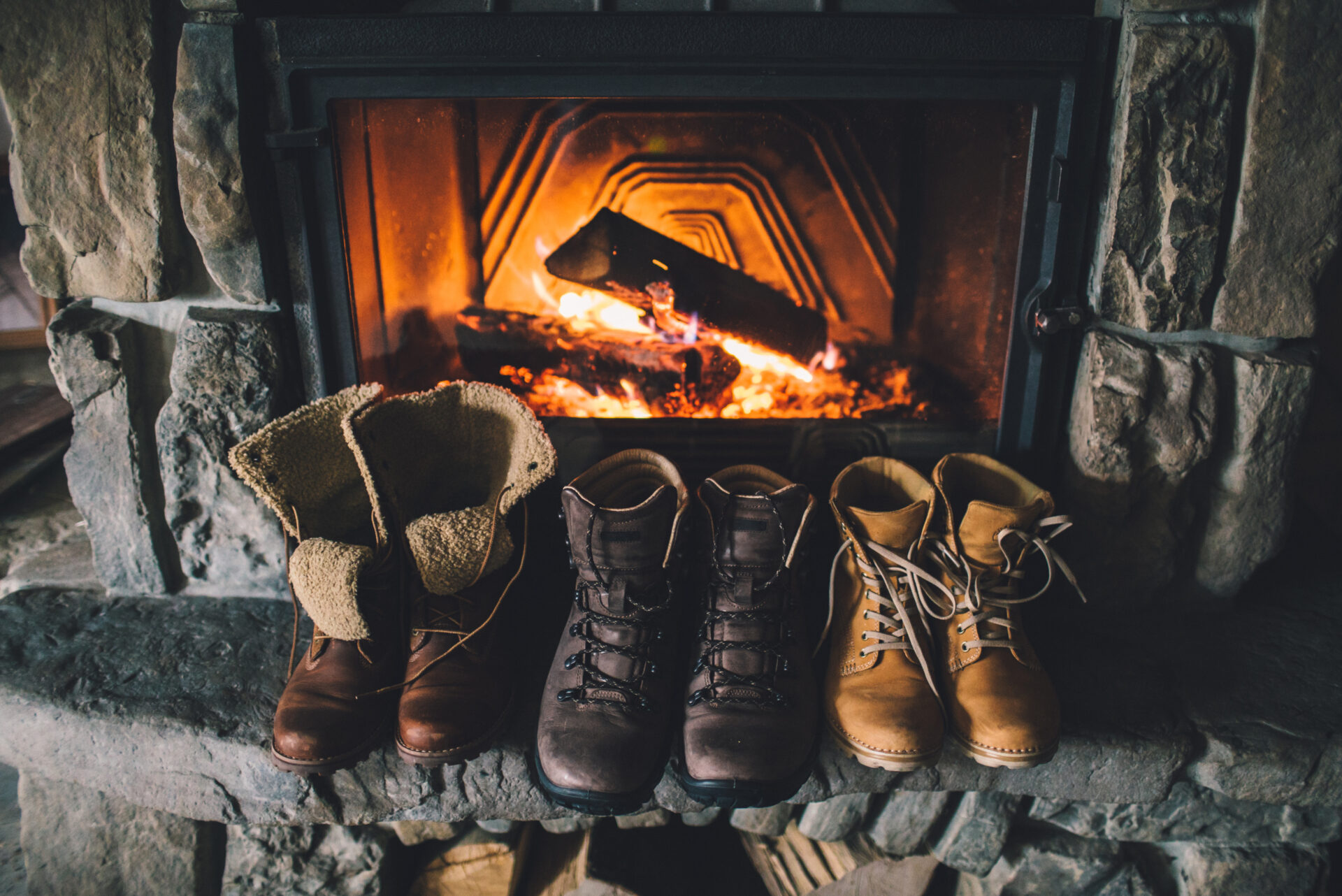
There are no stockings hung on the fireplace in France. Instead, one of the more common French Christmas traditions is for children to leave shoes or socks in the hope that Santa Claus – whom they refer to as Père Noël (Father Christmas) — will fill them with presents and sweet treats.
6. Children Write Letters to Père Noël…and He Writes Back!
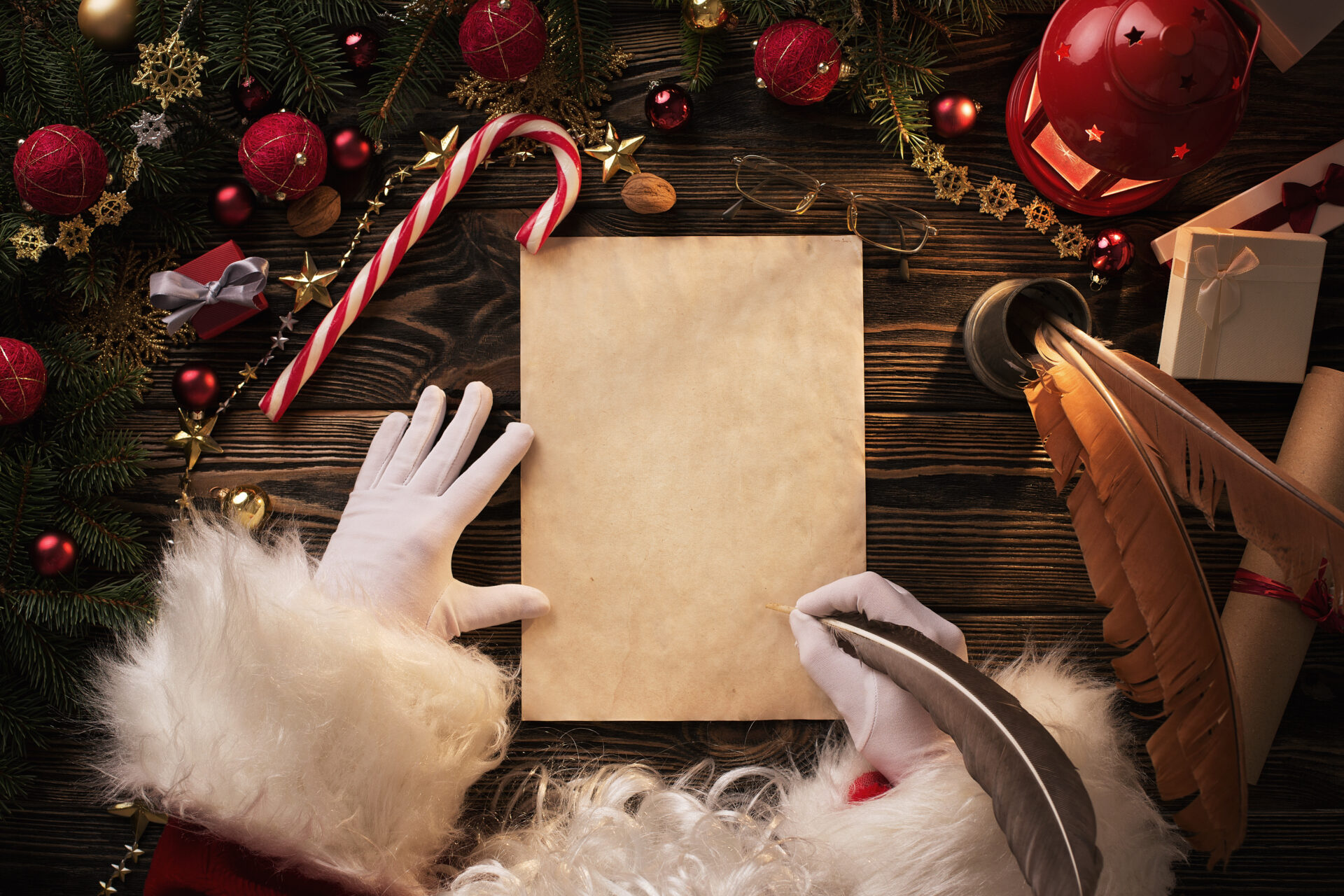
In 1962, a law was passed dictating that anyone who writers a letter to Santa must receive a postcard in response, and this French Christmas tradition is still in place today. Letters must be mailed by December 20, and they don’t need an address: Père Noël on the front of the card will suffice. Alternatively, letters can be submitted electronically.
7. Religious French Families Attend Midnight Mass
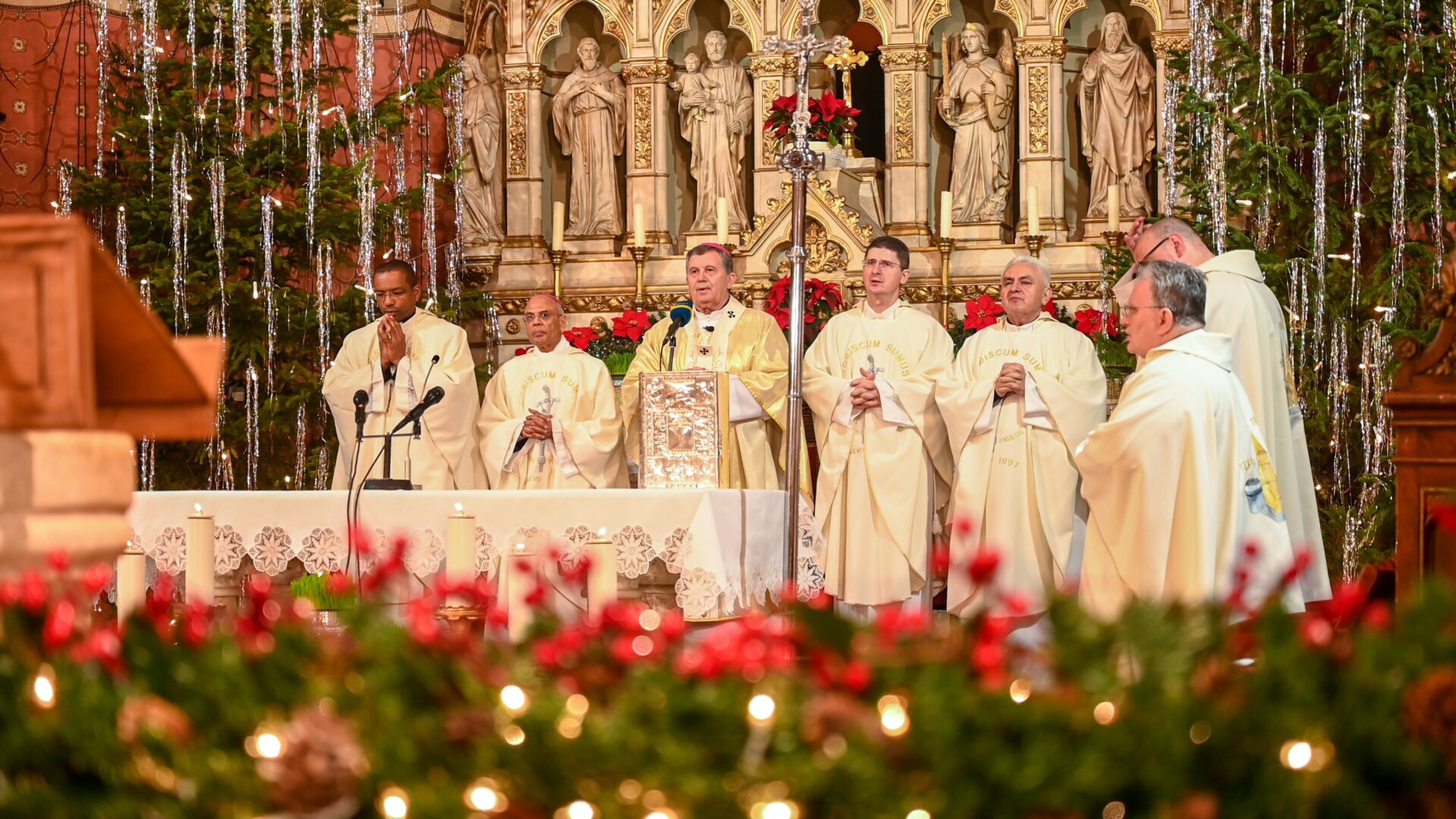
It’s common to wait until midnight to attend mass in France, although you’d typically arrive earlier for Christmas carols beforehand. Whether it’s the late hour, the darkness of the night, the palpable sense of joy in the air, the candles lit in the nave of the church, or some combination of all of the above, there’s something magical about midnight mass.
If you’re looking for a mass to attend on Christmas Eve — or should we say Christmas morning — in Paris, we recommend the Basilica of Sacré-Coeur de Montmartre or the Madeleine.
8. There’s an Elaborate, Multi-Course Christmas Eve Meal That Ends With a Bûche de Noël
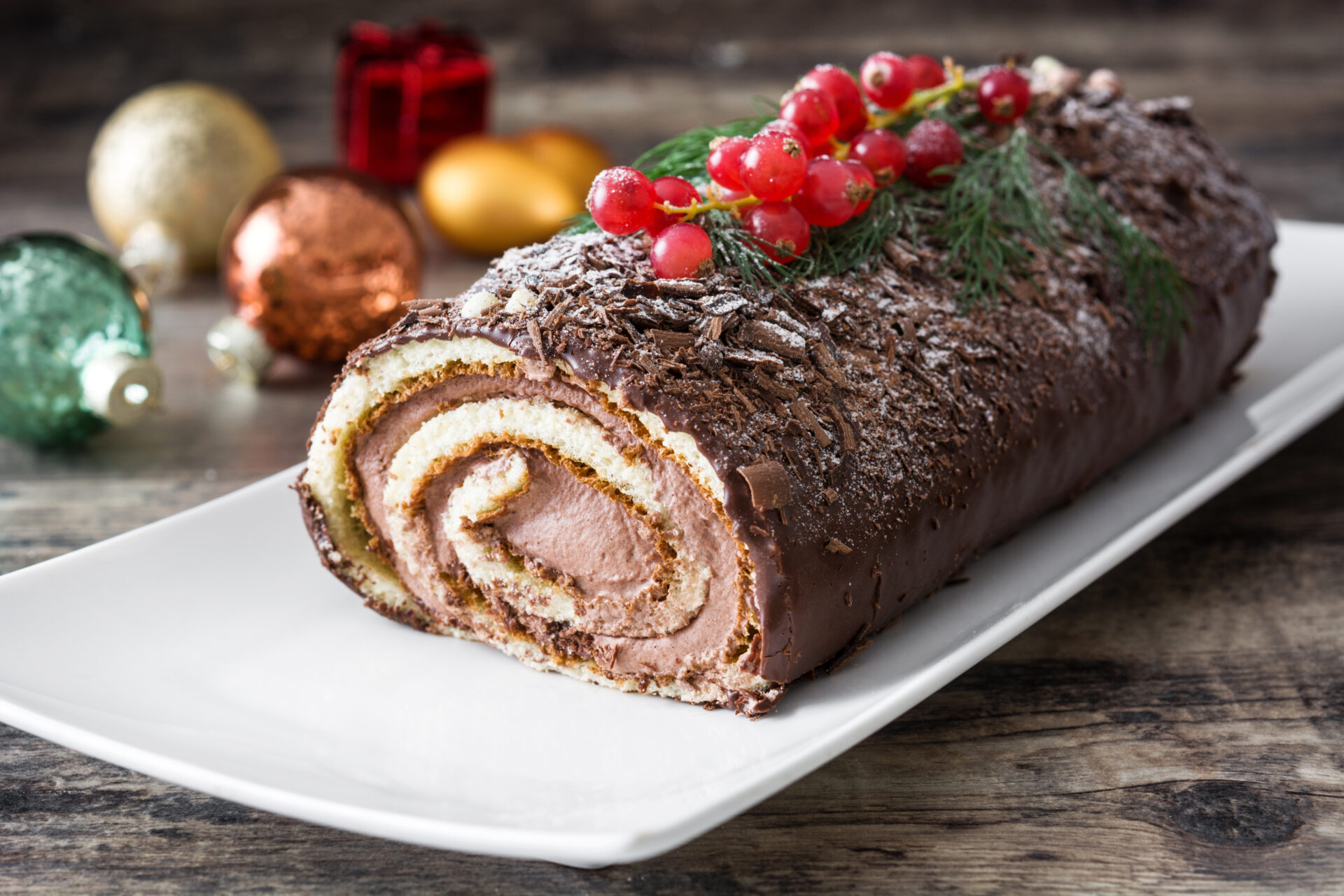
In France, the celebratory meal is traditionally enjoyed on Christmas Eve, not Christmas Day — although given how late the meal starts and how long it lasts (sometimes up to six hours!), the two days tend to blend together. It’s called Le Réveillon de Noël, which is derived from the verb réveiller (to wake up) and refers to the practice of staying up all night to wait for Père Noël.
In traditional French fashion, the meal starts with a l’apéro of Champagne and small bites, followed by a hearty meal where foie gras and bread will likely make an appearance alongside escargots, chestnut velouté, and seafood (smoked salmon, oysters, scallops, Coquilles Saint Jacques, and langoustines are popular among families who can spring for these luxuries). The main course is typically a chestnut-stuffed turkey, followed by a salad and…because we’re not done yet…the cheese course, all of which is washed down with a steady supply of Champagne and wine. And to end on a sweet note, there will be a bûche de Noël, also known as a yule log. This French dessert, which is a classic during the Christmas season, is made with two rolled layers: one vanilla Génoise cake and another dark chocolate buttercream cake. Garnishes vary but may include chopped pistachios, a simple dusting of powdered sugar, macarons shaped like mushrooms, or cranberries and rosemary.
9. In Provence, The Christmas Meal Ends With 13 (Yes, 13!) Desserts

Said to represent Jesus and his twelve apostles, the treize desserts typically include sweets made with nuts and fresh or dried fruits. It’s also common to have two types of nougat representing good versus evil: a white nougat made with pistachios, sugar, and eggs; and a dark nougat made with honey and almonds.
All desserts are spread out on the dining table at once so guests can take a little bit of everything.
10. There’s a Galette des Rois to Celebrate The Epiphany
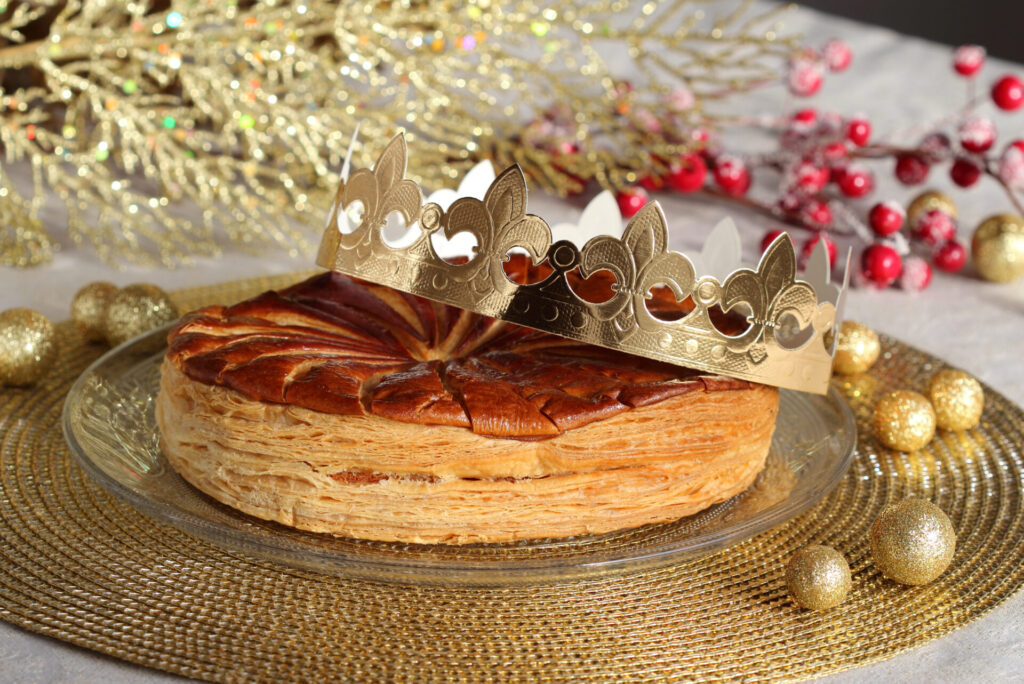
January 6 is the Epiphany, the day the Three Kings visited baby Jesus. To celebrate la fête des rois (the kings’ feast), the French bake la galette des rois (King Cake) with flaky puff pastry and a creamy almond filling called frangipane. (Though it has the same name, the French King Cake is very different from its New Orleans cousin.) But the real treat (though inedible) is the fève, or figurine, inside. As French tradition goes, whoever gets served a piece with the figurine inside becomes the crowned king or queen of the day and, as a prize, gets to wear a colorful paper crown.
You may notice that the practice of sending Christmas cards isn’t on the list. While some people do send cartes de vœox, it’s not very common. And if it does occur, it’s more likely it’ll be for the New Year than Christmas.
Questions about French Christmas traditions? We’ve got answers.
When Do The French Celebrate Christmas?
The French celebrate Christmas on December 25. However, there are traditional festivities that take place before and after. December 24 is often the main day of celebrating, so that people can kick back and relax on the 25th.
December 6 is Saint Nicholas Day which, for some French families kicks off gifting season. According to tradition, Saint Nicholas enter houses through the chimneys to deliver sweets to well-behaved children…but he’s not alone. He’s accompanied by Père Fouettard, who’s tasked with delivering coal, a bundle of twigs, or potatoes to naughty children.
The holiday season runs through New Year’s Eve and into January when, as mentioned above, the Epiphany is celebrated on January 6th with a King Cake.
What Do They Call Santa Claus in France?
In France, Santa is called Père Noël (or, for younger children, Papa Noël), which translates to “Father Christmas.” In certain parts of France, however, he’s better known as Sant Nicholas — also spelled as Saint Nicolas — the bearer of gifts on December 6.
When is The French Greeting For “Merry Christmas” Used?
Unlike in other countries where it’s socially acceptable to wish someone a Merry Christmas any time in throughout the Christmas season, in France it’s customary to say Joyeux Noël only during Christmas week itself (you can also say Bonnes Fêtes).
When Do The French Set Up Their Christmas Tree?
The tradition of decorating a fir tree originated in Alsace in the 16th century. At the time, the trees were adorned with apples and set up, per Catholic tradition, on Christmas Eve. These days, however, you’ll find the French decorating their sapins de Noël at any point in December — likely earlier in the month — and keeping them up through the Epiphany on January 6.
How is Christmas in France Different Than in America?
While the Christmas spirit of joy, gratitude, and community is a shared one, there are certain French Christmas traditions unique to the country.
In France, December 24 rather than the 25th is typically when families gather, exchange gifts, and indulge in their Christmas feast. Speaking of feasting, many French Christmas traditions revolve around culinary delights (versus gifting and decorating in the U.S.). From les marché de Noël to the elaborate Christmas dinner, food is a focal point.
Another major difference: the U.S. versus French Christmas tradition around Santa. In the U.S., he makes an appearance on one night and one night only. But in France, Saint Nicholas may come bearing treats as early as December 6, while Père Noël makes his rounds later in the month on Christmas Day, stuffing shoes with treats rather than placing them under Christmas trees as he does in America.
Jacqueline Parisi is a Brooklyn-based content strategist, writer, and copywriter with an appetite for all things French. She holds a BA in English & French from Boston College and an MA in French Studies from NYU. Her graduate research focused on refugees in Paris via the intersection of food, identity, and memory. When not working, she can usually be found on the yoga mat, watching French Netflix, or reading for the one-too-many book clubs she’s a part of. Find her previously published work here.

